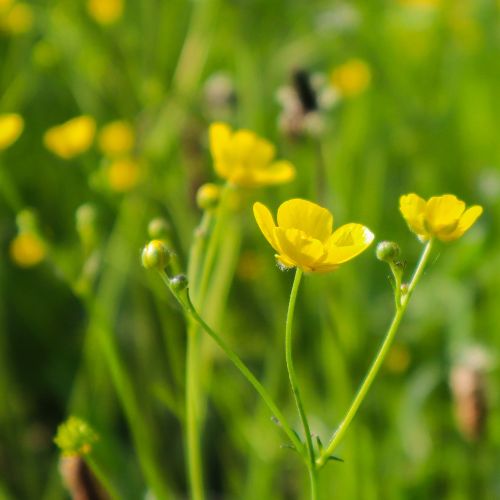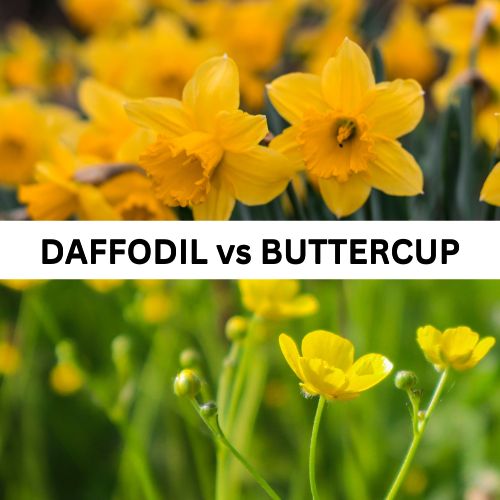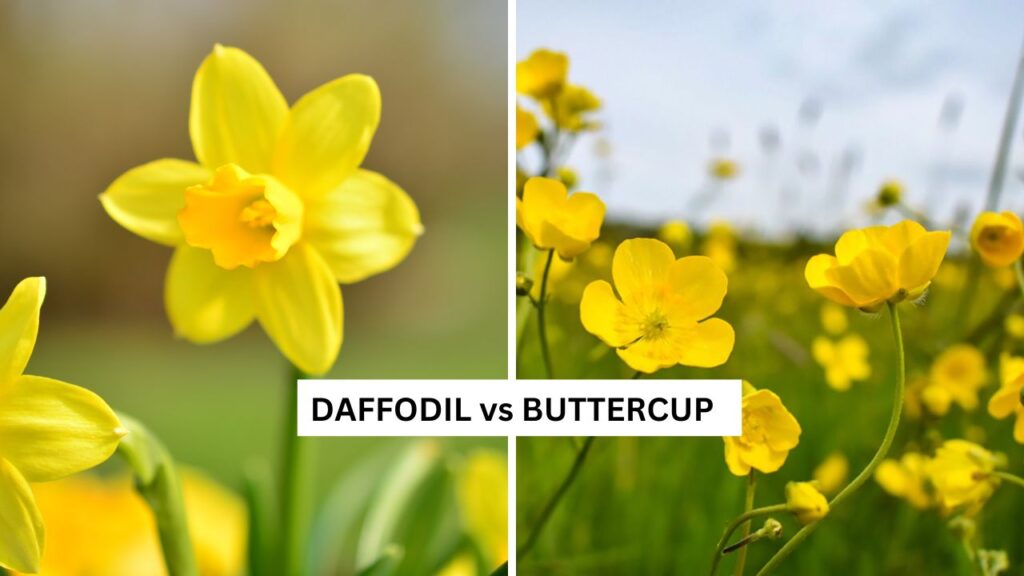Daffodil vs Buttercup
Flowers, with their vibrant colors and delicate structures, have captivated humans for centuries. They have the magical ability to brighten our surroundings and evoke joy and serenity. Among the vast array of floral beauties, daffodils and buttercups stand out as iconic symbols of spring and sunshine.
Their cheerful yellow hues bring warmth and radiance to gardens, meadows, and landscapes worldwide. While both daffodils and buttercups share a commonality in their color palette, they possess distinct characteristics that set them apart. This blog post will delve into the world of daffodils and buttercups, exploring their unique features, symbolism, cultivation, and more, ultimately determining which of these two blossoms truly shines as nature’s radiant masterpiece.
Daffodil

Daffodils, also known as Narcissus, are quintessential spring flowers that grace our gardens with their vibrant colors and distinct trumpet-like shape. These cheerful blossoms are cherished for their ability to bring a sense of joy and renewal after the cold winter months. Let’s explore the features that make daffodils truly remarkable:
Description and Physical Characteristics
Daffodils belong to the Amaryllidaceae family and are native to Europe, North Africa, and Asia. They are herbaceous perennials characterized by their long, narrow leaves and tall stems that bear one or more flowers. Daffodil flowers consist of six petals, with an outer ring of three larger petals called the “tepals” and an inner ring of three smaller, trumpet-shaped petals known as the “corona.”
Shape and Structure of Daffodil Flowers
Daffodil flowers exhibit a wide range of shapes and sizes. The trumpet-shaped corona varies in length, from short and wide to long and slender. Some daffodils have cups that are smooth and rounded, while others have frilled or ruffled edges, adding an extra touch of elegance to their appearance. The tepals can be flat, slightly reflexed, or even swept back, creating diverse visual effects.
Diverse Range of Daffodil Varieties
Daffodils encompass a vast array of varieties, each with its unique charm and characteristics. From the classic “King Alfred” daffodil with its large, golden-yellow flowers to the delicate “Thalia” daffodil with its pure white petals, there is a daffodil to suit every taste and garden style. Some varieties exhibit multiple flowers per stem, creating beautiful clusters of blooms that enhance their visual impact.
Symbolism and Cultural Significance
Daffodils hold rich symbolism and cultural significance. They are often associated with the arrival of spring and are considered symbols of rebirth, renewal, and new beginnings. In many cultures, daffodils are exchanged as gifts to celebrate warmer weather’s arrival and express hope and optimism. These flowers have also been immortalized in literature and poetry, notably in William Wordsworth’s famous poem, “I Wandered Lonely as a Cloud” (commonly known as “Daffodils”).
Popular Varieties and Cultivation Tips
Growing daffodils is relatively easy, making them a popular choice for both novice and experienced gardeners. Numerous daffodil varieties are available, each with its preferred growing conditions and bloom times. Some popular varieties include the large and showy “Ice Follies,” the fragrant and bi-colored “Sailboat,” and the dainty and early-blooming “Tête-à-Tête.” Daffodils thrive in well-draining soil and require full sun or partial shade to reach their full potential. Planting daffodil bulbs in the fall allows them to establish their roots before the onset of winter.
Daffodils are stunning spring flowers that bring color and cheerfulness to any garden. Their diverse shapes, vibrant hues, and rich symbolism symbolize the beauty of new beginnings and the promise of brighter days. Whether you plant them in beds, borders, or containers, daffodils will captivate and inspire with their timeless charm.
Buttercup

Buttercups, with their bright and glossy petals, are charming flowers that bring a touch of sunshine to any landscape. These delicate blooms belong to the Ranunculus genus and are known for their cheerful yellow color and graceful appearance. Let’s explore the features that make buttercups truly enchanting.
Physical Characteristics of Buttercups
Buttercups are herbaceous perennial plants that belong to the Ranunculaceae family. They have slender stems and delicate foliage, which provide a beautiful backdrop for their vibrant flowers. The petals of buttercup flowers are typically glossy and come in shades of yellow, ranging from pale yellow to deep golden hues.
Structure and Appearance of Buttercup Flowers
Buttercup flowers consist of five to seven petals that are arranged in a cup-like shape. The petals are usually round or obovate in form and have a glossy texture that gives them a radiant and lustrous appearance. Some varieties of buttercups have additional petal-like structures called “nectaries” that surround the center of the flower, adding a touch of complexity to their overall look.
Varieties of Buttercups
There are several species and cultivars of buttercups, each with its unique characteristics. The meadow buttercup (Ranunculus acris) is a common variety with bright yellow flowers and deeply divided leaves. The Persian buttercup (Ranunculus asiaticus) is another popular type known for its large and showy flowers in various colors, including yellow, red, pink, and orange. The double-flowered varieties of buttercups, such as the “Bloomingdale,” feature multiple layers of petals, creating a lush and full appearance.
Symbolism and Cultural Significance
Buttercups have historically held symbolic meanings in various cultures. They are often associated with happiness, joy, and innocence. In folklore, it is said that holding a buttercup flower under the chin can reveal if someone likes butter, as a yellow reflection is believed to indicate a fondness for the dairy product. Buttercups have also been used in traditional medicine for their potential healing properties.
Growing and Caring for Buttercups
Buttercups thrive in well-draining soil and prefer areas with full sun or partial shade. They can be grown from seeds or propagated by division. Adequate watering and regular fertilization help ensure healthy growth and abundant blooms. It’s important to note that some species of buttercups can be invasive, so choosing cultivated varieties or containing them in controlled garden environments is recommended.
Buttercup flowers add a delightful touch of sunshine to gardens and landscapes. With their glossy petals, vibrant colors, and rich cultural symbolism, they bring joy and brightness wherever they bloom. Whether planted in meadows, borders, or containers, buttercups are sure to captivate and uplift with their delicate charm and radiant beauty.
Final Thoughts on Daffodil vs Buttercup

As we conclude our exploration of the daffodil versus buttercup debate, it becomes clear that both flowers possess unique characteristics and bring their own special charm to the natural world. Daffodils and buttercups, with their radiant yellow hues, symbolize the essence of sunshine and renewal, each in their own distinct way.
Daffodils, as the harbingers of spring, offer a regal and majestic presence. Their trumpet-like blooms and diverse range of varieties make them versatile and captivating additions to any garden or landscape. Daffodils symbolize rebirth, new beginnings, and the promise of brighter days. They have a strong cultural significance and have inspired poets and artists throughout history. With their elegant forms and vibrant colors, daffodils bring an energetic and uplifting atmosphere wherever they bloom.
Daffodil vs Buttercup

On the other hand, buttercups offer a delicate and playful charm. With their glossy petals and graceful appearance, they evoke a sense of joy and innocence. Buttercups symbolize happiness and are associated with simple pleasures and the beauty of nature’s creations. Their radiant yellow blooms add a touch of warmth and cheerfulness to meadows and gardens. While buttercups may have a shorter lifespan compared to daffodils, their fleeting beauty serves as a reminder to appreciate the transient moments in life.
The choice between daffodils and buttercups ultimately comes down to personal preference, context, and the desired emotional impact. Daffodils make a bold statement and lend themselves well to formal gardens, events, and arrangements. Their longevity and sturdiness make them a reliable choice for long-lasting beauty. With their delicate nature and playful allure, buttercups are perfect for creating a whimsical and enchanting atmosphere. They are ideal for casual gardens, wildflower meadows, or adding a pop of color to borders and containers.
Ultimately, whether you choose daffodils or buttercups, both flowers can uplift spirits and infuse our world with the magic of nature’s radiant beauty. They remind us to embrace new beginnings, cherish the fleeting moments, and find joy in life’s simple pleasures. So, as you encounter daffodils and buttercups in your surroundings, please take a moment to appreciate their unique qualities, soak in their vibrant colors, and let their presence inspire and rejuvenate your soul.